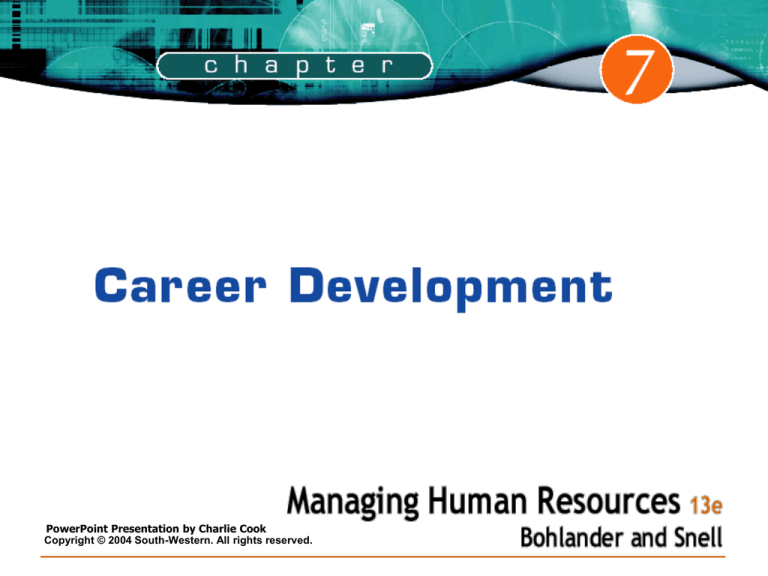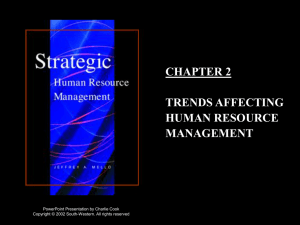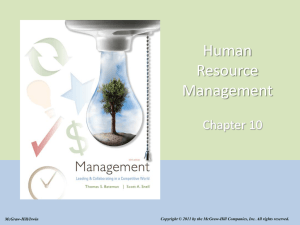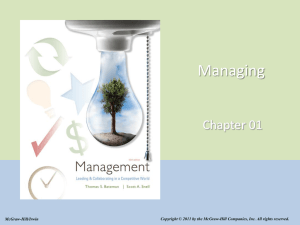
PowerPoint Presentation by Charlie Cook
Copyright © 2004 South-Western. All rights reserved.
Objectives
After studying this chapter, you should be able to:
1. Explain how a career development program
integrates individual and organizational needs.
2. Describe the conditions that help make a career
development program successful.
3. Discuss how job opportunities can be inventoried
and employee potential assessed.
4. Compare the methods used for identifying and
developing managerial talent.
5. Cite the ways in which employers can facilitate the
career development of women.
Copyright © 2004 South-Western. All rights reserved.
7–2
Objectives (cont’d)
After studying this chapter, you should be able to:
6. Discuss the ways in which employers can facilitate
the career development of members of minority
groups and of dual-career couples.
7. Describe the various aspects of personal career
development that one should consider.
Copyright © 2004 South-Western. All rights reserved.
7–3
Career Development: Creating Favorable
Conditions
• Management Participation
Provide top management
support
Provide collaboration
between line managers
and HR managers
Train management
personnel
• Setting Goals
Plan human resources
strategy
• Changing HR Policies
Provide for job rotation
Provide outplacement
service
• Announcing the Program
Explain its philosophy
Copyright © 2004 South-Western. All rights reserved.
Presentation Slide 7–1
7–4
Career Development: Determining
Employee Potential
• Career Planning Workbooks
Stimulate thinking about careers,
strengths/limitations, development needs
• Career Planning Workshops
Discuss and compare attitudes, concerns, plans
• Career Counseling
Discuss job, career interests, goals
Copyright © 2004 South-Western. All rights reserved.
Presentation Slide 7–2
7–5
HR’s Role in
Career
Development
THE GOAL: MATCH
INDIVIDUAL AND
ORGANIZATION NEEDS
--------------------------------•
•
•
•
The Goal: Matching
Encourage employee ownership
of career.
Create a supportive context.
Communicate direction of
company.
Establish mutual goal setting
and planning
1
IDENTIFY CAREER
OPPORTUNITIES AND
REQUIREMENTS
--------------------------------•
•
•
•
INSTITUTE CAREER
DEVELOPMENT
INITIATIVES
-----------------------------------•
•
•
•
•
Career Development Initiatives
Provide workbooks and
workshops.
Provide career counseling.
Provide career self-management
training.
Give developmental feedback.
Provide mentoring.
Figure 7.1
Presentation Slide 7–3
Copyright © 2004 South-Western. All rights reserved.
4
Opportunities & Requirements
Identify future competency
needs.
Establish job
progressions/career paths.
Balance promotions, transfers,
exits, etc.
Establish dual career paths.
2
GAUGE
EMPLOYEE
POTENTIAL
--------------------------------•
•
•
•
Gauge Employee Potential
Measure competencies
(appraisals).
Establish talent inventories.
Establish succession plans.
Use assessment centers.
3
7–6
The Goal: Matching Individual and
Organizational Needs
• The Employee’s Role
• The Organization’s Role: Establishing a
Favorable Context
• Blending Individual and Organizational Goals
Copyright © 2004 South-Western. All rights reserved.
7–7
Balancing Individual and Organizational Needs
Copyright © 2004 South-Western. All rights reserved.
Figure 7.2
7–8
Identifying Career Opportunities and
Requirements
• Competency Analysis
Measures three basic competencies for each job:
know-how, problem solving, and accountability.
• Job Progressions
The hierarchy of jobs a new employee might
experience, ranging from a starting job to jobs
that require more knowledge and/or skill.
• Career Paths
Lines of advancement in an occupational field
within an organization.
Copyright © 2004 South-Western. All rights reserved.
7–9
Typical Line of Advancement in HR Management
Copyright © 2004 South-Western. All rights reserved.
Figure 7.3
7–10
Career Path Of Colin Powell
1954
Joins ROTC program
1957
Enrolls in City College of New York 1963 Tour of duty in Vietnam
1968
Graduates from U.S. Army Command and General Staff College (CGSC)
1971
Graduate School at the George Washington University
1972
White House Fellow under President Richard Nixon
1974
Commander of 1st Battalion, 32nd Infantry in Korea
1977
Colonel, Commander of 2nd Brigade, 101st Infantry
1978
Works in Office of Secretary of Defense under President Jimmy Carter
1982
Brigadier General, Commander of 4th Infantry Division
1982
Deputy Commanding General of Combined Arms Combat Developments Activity
1987
National Security Advisor under President Ronald Reagan
1989
Chairman, Joint Chiefs of Staff under President George Bush
1992
Approached to be Bill Clinton’s vice presidential running mate (declined)
1993
Chairman, Joint Chiefs of Staff under President Bill Clinton
1993
Retired from military service
2000
Secretary of State under President George W. Bush
Copyright © 2004 South-Western. All rights reserved.
HRM 1
7–11
Career Changes
• Promotion
A change of assignment to a job at a higher level
in the organization.
Principal criteria for determining promotions are
merit, seniority, and potential.
• Transfer
The placement of an individual in another job for
which the duties, responsibilities, status, and
remuneration are approximately equal to those of
the previous job.
Copyright © 2004 South-Western. All rights reserved.
7–12
Career Change Organizational Assistance
• Relocation services
Services provided to an employee who is
transferred to a new location:
Help in moving, in selling a home, in orienting to a new
culture, and/or in learning a new language.
• Outplacement services
Services provided by organizations to help
terminated employees find a new job.
Copyright © 2004 South-Western. All rights reserved.
7–13
Alternative Career Moves
Copyright © 2004 South-Western. All rights reserved.
Figure 7.4
7–14
Dual Career Tracks: Xenova System
Scientist
Senior Scientist
Section Leader
Research Associate
Department Head
Principal Scientist
Source: Adapted from Alan Garmonsway of Xenova and Michael Wellin of Behavioral
Transformation, “Creating the Right Natural Chemistry,” People Management 1, no. 19
(September 21, 1995): 36–39.
Copyright © 2004 South-Western. All rights reserved.
HRM 2
7–15
Human Capital Profiles for Two Different Careers
Source: Scott Snell, Cornell University.
Copyright © 2004 South-Western. All rights reserved.
Figure 7.5
7–16
Using Assessment Centers
• Assessment Center
A process by which individuals are evaluated as
they participate in a series of situations that
resemble what they might be called upon to
handle on the job.
In-basket training
A process for evaluating trainees by simulating a real-life
work situation
Leaderless group discussions
A process that places trainees in a conference setting to
discuss an assigned topic, either with or without
designated group roles
Copyright © 2004 South-Western. All rights reserved.
7–17
Successful Career-Management Practices
• Placing clear expectations on employees.
• Giving employees the opportunity for transfer.
• Providing a clear and thorough succession plan
• Encouraging performance through rewards and
recognition.
• Giving employees the time and resources they need
to consider short- and long-term career goals.
• Encouraging employees to continually assess their
skills and career direction.
Copyright © 2004 South-Western. All rights reserved.
7–18
Internal Barriers to Career Advancement
• Lack of time, budgets, and resources for
employees to plan their careers and to
undertake training and development.
• Rigid job specifications, lack of leadership
support for career management, and a shortterm focus.
• Lack of career opportunities and pathways
within the organization for employees.
Copyright © 2004 South-Western. All rights reserved.
7–19
Career Development Initiatives
• Career Planning Workbooks
• Career Planning Workshops
• Career Counseling
The process of discussing with employees their
current job activities and performance, their
personal and career interests and goals, their
personal skills, and suitable career development
objectives.
Copyright © 2004 South-Western. All rights reserved.
7–20
Individualized Career Development
• Fast-track Program
A program that encourages young managers with
high potential to remain with an organization by
enabling them to advance more rapidly than those
with less potential.
• Career Self-Management Training
Helping employees learn to continuously gather
feedback and information about their careers.
Encouraging them to prepare for mobility.
Copyright © 2004 South-Western. All rights reserved.
7–21
Mentoring
• Mentors
Executives who coach, advise, and encourage
individuals of lesser rank.
• Mentoring functions
Functions concerned with the career
advancement and psychological aspects of the
person being mentored.
Copyright © 2004 South-Western. All rights reserved.
7–22
Top Ten Myths about Mentors
1. Mentors exist only for
career development.
6. Mentor relationships just
happen.
2. You need only one
mentor.
7. Highly profiled people
make the best mentors.
3. Mentoring is a one-way
process.
8. Once a mentor, always
a mentor.
4. A mentor has to be older
than the protégé.
9. Mentoring is a
complicated process.
5. A mentor has to be the
same gender and race
as the protégé.
10. Mentor-protégé
expectations are the
same for everyone.
Copyright © 2004 South-Western. All rights reserved.
Figure 7.6
7–23
Mentoring Functions
Source: Matt Starcevich, Ph.D. and Fred Friend, “Effective Mentoring Relationships from
the Mentee’s Perspective,” Workforce, supplement (July 1999): 2–3. Used with permission
of the Center for Coaching and Mentoring, Inc., http://coachingandmentoring.com/.
Copyright © 2004 South-Western. All rights reserved.
Figure 7.7
7–24
Forming a Mentoring Relationship
• Research the mentor’s background.
• Make contact with the mentor.
• Request help on a particular matter.
• Consider what you can offer in exchange.
• Arrange a meeting.
• Follow up.
• Ask to meet on an
ongoing basis.
Copyright © 2004 South-Western. All rights reserved.
7–25
Mentor Checklist
Source: Excerpted with permission of the publisher from Connecting with Success: How to Build Your
Mentoring Network to Fast-Forward Your Career, by Kathleen Barton; Davis-Black Publishing, 800.624.1765.
Copyright © 2004 South-Western. All rights reserved.
HRM 5
7–26
Career Networking Contacts
• Your college alumni association or career office
networking lists
• Your own extended family
• Your friends’ parents and other family members
• Your professors, advisors, coaches, tutors, clergy
• Your former bosses and your friends’ and family
members’ bosses
• Members of clubs, religious groups, and other
organizations to which you belong
• All of the organizations near where you live or go to
school
Copyright © 2004 South-Western. All rights reserved.
7–27
Career Development for Women
• The “Glass Ceiling”
Artificial barriers based on attitudinal or
organizational bias that prevent qualified women
from advancing upward in their organizations into
management level positions.
• Eliminating Barriers to Advancement
Development of women’s networks
Online e-mentoring for women
Diminishing stereotyping of women
Presence of women in significant managerial
positions
Copyright © 2004 South-Western. All rights reserved.
7–28
Glass-Ceiling Audits
• Glass ceiling audit factors:
Upper-level management and executive training
Rotational assignments International assignments
Opportunities for promotion
Opportunities for executive development programs at
universities
Desirable compensation packages
Opportunities to participate on high-profile project
teams
Upper-level special assignments
Copyright © 2004 South-Western. All rights reserved.
7–29
The Top Ten Highest-Paid Women in America
RANK EXECUTIVE NAME/TITLE/COMPANY NAME
ANNUAL LONG-TERM
COMP.
COMP.
MILLIONS
2000
COMP.
1.
HEATHER KILLEN, Senior VP, Yahoo!
$0.3
$32.5
$32.7
2.
DAWN G. LEPORE, Vice-Chmn., Exec. VP & CIO, Charles Schwab
2.1
20.2
22.3
3.
M. ZITA COBB, Executive VP, JDS Uniphase
0.4
18.3
18.7
4.
SUSAN D. DESMOND-HELLMANN, Executive VP, Genentech
0.9
15.2
16.1
5.
TERRI A. DIAL, Group Executive VP, Wells Fargo
2.0
10.7
12.8
6.
JANICE M. ROBERTS, Senior VP, 3Com
0.5
11.7
12.2
7.
LOIS D. JULIBER, COO, Colgate-Palmolive
1.6
10.6
12.2
8.
DONNA S. BINKS, Executive VP & CFO, Adaptive Broadband
0.5
10.0
10.4
9.
DEBORAH C. HOPKINS, Executive VP & CFO, Lucent Technologies 5.2
4.3
9.5
1.9
9.4
10. LESLIE C. TORTORA, CIO, Goldman Sachs Group
7.5
Data: Execucomp, provided by Standard & Poor’s Institutional Market Services, a division of the McGraw-Hill Companies
Source: Louis Lavelle, “For Female CEOs, It’s Stingy at the Top,” Business Week (April 23, 2001).
Copyright © 2004 South-Western. All rights reserved.
Figure 7.8
7–30
Career Development for Minorities
• Career development for minorities is advanced
by:
Organizational support for the advancement of
minorities to significant management positions
Provision of internships to attract minorities to
management careers
Organization of training courses to foster the
development of minority’s managerial skills and
knowledge.
Copyright © 2004 South-Western. All rights reserved.
7–31
Dual-Career Couples
• Dual-Career Partnerships
Couples in which both members follow their own
careers and actively support each other’s career
development.
Flexible work schedules
Adaptive leave policies
Work-at-home
On-premises day care
Job sharing
Copyright © 2004 South-Western. All rights reserved.
7–32
Stages of Career Development
Stage 5: Late Career (ages 55–retirement):
Remain productive in work, maintain self-esteem, prepare for effective
retirement.
Stage 4: Midcareer (ages 40–55):
Reappraise early career and early adulthood goals, reaffirm or modify goals,
make choices appropriate to middle adult years, remain productive.
Stage 3: Early Career (ages 25–40):
Learn job, learn organizational rules and norms, fit into chosen occupation
and organization, increase competence, pursue goals.
Stage 2: Organizational Entry (ages 18–25):
Obtain job offer(s) from desired organization(s), select appropriate job based
on complete and accurate information.
Stage 1: Preparation for Work (ages 0–25):
Develop occupational self-image, assess alternative occupations, develop
initial occupational choice, pursue necessary education.
Figure 7.9
Presentation Slide 7–4
Copyright © 2004 South-Western. All rights reserved.
7–33
Source: Mindy Charski, “Have We Got a Job for You: Move Over, Nostradamus. Here’s the HelpWanted Dope,” U.S. News & World Report 127, no. 17 (1999): 93–102. See also Justin Ewers, “The
New Hot Jobs on Campus,” U.S. News & World Report 133, no. 12 (2002): 96.
Copyright © 2004 South-Western. All rights reserved.
HRM 8
7–34
CISS Orientation and Basic Scales
• Influencing
Leadership, law/politics,
public speaking, sales,
advertising
• Organizing
Supervision, financial
services, office practices
• Analyzing
Mathematics, science
• Helping
Adult development,
counseling, child
development, religious
activities, medical practice
• Creating
Art/design, performing arts,
writing, international
activities, fashion, culinary
arts
• Producing
Mechanical crafts, woodworking, farming/forestry,
Plants/gardens, animal care
• Adventuring
Athletics/physical fitness,
military/law enforcement,
risks/adventure
Source: ©1992 David Campbell, Ph.D. All rights reserved. Published and distributed by NCS
Assessments, P.O. Box 1416 Minneapolis, MN 55440. Reproduced with permission. “Campbell
Interest and Skill Survey” and “CISS” are both registered trademarks of David Campbell, Ph.D.
Copyright © 2004 South-Western. All rights reserved.
Presentation Slide 7–5
7–35
High
Combinations of Career Interests and Skills
Pursue
Avoid
Develop
Low
SKILLS
Explore
Low
High
INTERESTS
Copyright © 2004 South-Western. All rights reserved.
Figure 7.10
Presentation Slide 7–6
7–36
The Plateauing Trap
• Career Plateau
Situation in which for either organizational or
personal reasons the probability of moving up the
career ladder is low.
• Types of Plateaus
Structural plateau: end of advancement
Content plateau: lack of challenge
Life plateau: crisis of personal identity
Copyright © 2004 South-Western. All rights reserved.
7–37
Twelve Steps for Starting a New Business
Source: From Business in a Changing World, 3rd edition, by W. Cunningham, R. Aldag, and S. Block: 139 © 1993.
Reprinted with permission of South-Western College Publishing, a division of Thomson Learning. Fax 800-730-2215.
Copyright © 2004 South-Western. All rights reserved.
Figure 7.12
7–38
Keeping a Career in Perspective
• Maintaining Off-the-Job Interests
• Having a Healthy Marital and/or Family Life
• Planning for Retirement
• Maintaining a Healthy Balance
Copyright © 2004 South-Western. All rights reserved.
7–39






